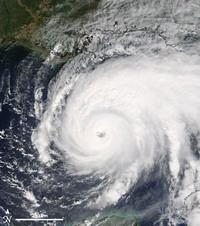Coastal residents are still not prepared for hurricanes
Atlantic and Gulf Coasts still lack a hurricane survival plan and do not feel vulnerable to storms, despite Katrina's dramatic damage and pleas from emergency officials for residents to prepare before the season starts.

The six-month Atlantic hurricane season starts Friday, and forecasters have predicted an above-average year: 13 to 17 named storms, with seven to 10 of them becoming hurricanes and three to five of those major ones of at least Category 3 strength with winds above 111 mph (179 kph). One forecaster said odds were high that a major hurricane would hit the U.S. this year.
Nevertheless, 53 percent of those surveyed in 18 Atlantic and Gulf Coast states say they do not feel that they are vulnerable to a hurricane, or to related tornadoes and flooding, according to the Mason-Dixon poll.
Eighty-eight percent said they had not taken any steps to fortify their homes, and 45 percent still mistakenly believed that masking tape helps keeps windows from shattering during hurricanes.
National Hurricane Center Director Bill Proenza said a population shift to the nation's coastlines may be contributing to the lack of storm readiness.
"We actually have more and more people ... with little or no experience with hurricanes and tropical storms," Proenza said.
But only a small amount of people, 16 percent, said they would defy orders to evacuate.
Cathy Miller, who lives on North Carolina's narrow Ocracoke Island, accessible only by ferry, is one of them - unless it's a Category 4 - with winds from 131 mph (211 kph) to 155 mph (249 kph) - or worse hurricane.
"I've never evacuated," Miller said. "Every time I say that, though, I knock on wood."
Public safety officials tell residents to stockpile at least a three-day supply of bottled water, nonperishable food and medicine. In Florida, officials urged residents to take advantage of a state sales tax holiday from Friday to June 12 on flashlights, gasoline cans, weather radios, plastic tarps and other storm preparedness items.
Nearly half of hurricanes that made landfall in the U.S. hit Florida, and its residents were more prepared than people in other states. About two-thirds of Floridians had a disaster plan, prepared a survival kit or said they felt vulnerable to hurricanes, the poll found.
Nationally, 61 percent of poll respondents had no hurricane survival kit. Of those who did, 82 percent packed a fire hazard - candles or kerosene lamps. Missing from most of those kits were axes, which emergency officials recommended after many residents were trapped in their attics after Katrina.
Despite the predictions for a busy season, public safety officials worry that an uneventful 2006 lulled residents into complacency; there were only 10 named storms, and the two that hit the U.S. were weak.
Researcher William Gray, based at Colorado State University, said Thursday there was a 74 percent chance of a major hurricane hitting the U.S. coast this year. His updated forecast still predicts 17 named storms and nine hurricanes, five of them intense.
There is a 50 percent chance of a major hurricane making landfall on the East Coast, including the Florida Peninsula, according to the new forecast; the long-term average is 31 percent. The chance of a major hurricane hitting the Gulf Coast between the Florida Panhandle and Brownsville, Texas, is 49 percent; the long-term average is 30 percent. There is also an above-average chance of a major hurricane making landfall in the Caribbean, Gray said.
In 2004, there were 15 named storms, four of them hurricanes that struck Florida. The 2005 season set a record with 28 named storms, 15 of them hurricanes; four of those hurricanes hit the U.S. coast, including Katrina, the third deadliest in U.S. history with a death toll topping 1,500.
"Nobody in this country thought we could lose 1,000 people in a hurricane," said Craig Fugate, director of the Florida Division of Emergency Management. "We had too much technology, too good data, satellites and the best warning system in the world - and it happened. Preparation is how we change that."
The poll was commissioned by the organizers of the 2007 National Hurricane Survival Initiative. The group includes the National Hurricane Center, the Federal Emergency Management Agency, the National Emergency Management Association, the Salvation Army and others.
The May 10-15 telephone poll of 1,100 people has a margin of sampling error of plus or minus 3 percentage points. The Florida poll of 625 people from May 13-15 had a margin of sampling error of plus or minus 4 percentage points.
Subscribe to Pravda.Ru Telegram channel, Facebook, RSS!


